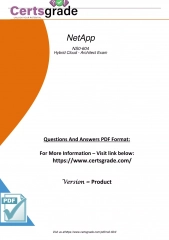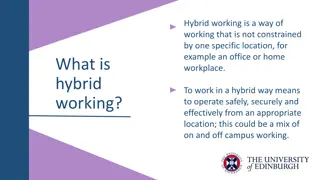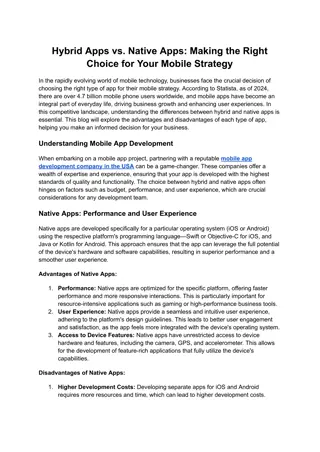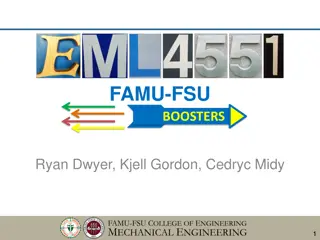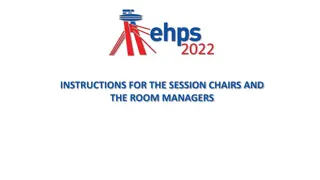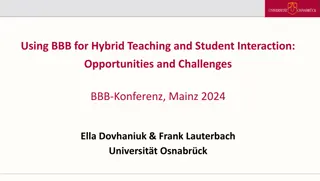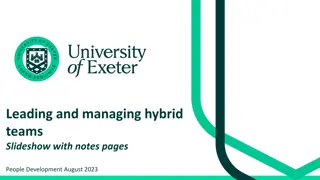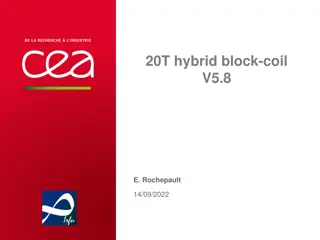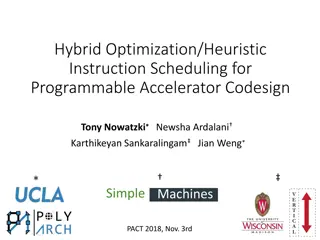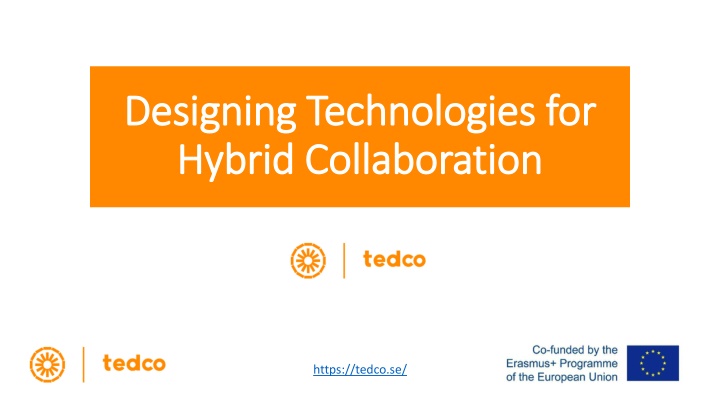
Hybrid Collaboration Technologies and Design Principles
Explore the intricacies of hybrid collaboration technologies and their design aspects, focusing on recognizing, analyzing, and integrating hybrid collaboration elements. Discover relevant factors and learn how hybridity impacts collaborative interactions. Recommended readings offer insights into the evolving landscape of hybrid collaboration research.
Uploaded on | 0 Views
Download Presentation

Please find below an Image/Link to download the presentation.
The content on the website is provided AS IS for your information and personal use only. It may not be sold, licensed, or shared on other websites without obtaining consent from the author. If you encounter any issues during the download, it is possible that the publisher has removed the file from their server.
You are allowed to download the files provided on this website for personal or commercial use, subject to the condition that they are used lawfully. All files are the property of their respective owners.
The content on the website is provided AS IS for your information and personal use only. It may not be sold, licensed, or shared on other websites without obtaining consent from the author.
E N D
Presentation Transcript
Designing Designing Technologies for Technologies for Hybrid Hybrid Collaboration Collaboration https://tedco.se/
Summary Summary & Learning & Learning goals goals Summary: Learning goals: recognize hybrid collaboration aspects of collaborative technologies describe relevant hybrid collaboration aspects of collaborative technologies in oral and visual form. analyse and integrate hybrid collaboration aspects in the design of collaborative technologies. The students are introduced to relevant factors for recognizing, analysing and designing technology to support hybrid collaborative interaction. This includes understanding how hybridity matters to the tools and processes of collaboration and unpack how hybridity matters when it confers an asymmetry on the coordination that occurs within the interrelated concepts of collaboration.
Recommended Recommended readings readings Thomas Neumayr, Banu Saat i, Sean Rintel, Clemens N. Klokmose & Mirjam Augstein (2021). What was Hybrid? A Systematic Review of Hybrid Collaboration and Meetings Research. Manuscript in preparation for submission to the Journal of Computer Supported Cooperative Work (JCSCW)
Contents Contents Definition Hybrid design challenges Focal points Summary References
Definition: Definition: Collaboration Collaboration Examples: The highest, synergistic form of working together. Denning & Yaholkovsky, 2008 Collaboration. This is that goes beyond their own individual expertise and vision to complete a task or project. In contrast to a process involving various individuals who may see different aspect of a problem. They engage in a process cooperation, collaboration involves creating a solution or a product that is more than the sum of each participant s contribution. Shah. 2010. co-ordinated, synchronous activity that is the result of a continued attempt to construct and maintain a shared conception of a problem Roschelle and Teasley, 1995, p. 70) There is not one definition there are many and terms are used interchangeably
Definition: Hybrid Definition: Hybrid Examples: We define hybrid work as situations where at least three actors are located at fewer geographical sites than the number of actors, and all actors are mutually dependent in their work. Duckert et al, forthcoming. hybrid collaboration refers to collaborative practices that involve simultaneous co-located and remote collaboration with phases of both synchronous and asynchronous work that spans multiple groupware applications and devices Neumayr et al, 2018 hybrid meetings refers to video- or audio-based communication sessions among co-located and remote participants. Saat i et al, 2019. hybrid collaboration and meetings (HCM), Neumayr, et al, 2021. There is not one definition there are many and terms are used interchangeably
Definition: Hybrid Definition: Hybrid There is not one definition there are many and terms are used interchangeably See examples in table The particular term hybrid was used only rarely in the years up until 2019 (before COVID-19 pandemic) to characterize research described now under this notion. Neumayr, et al (2021). What was Hybrid? A Systematic Review of Hybrid Collaboration and Meetings Research.
Definition: Definition: Time Time/space matrix /space matrix Time is a continuum instead of a dichotomy Lee & Paine. 2015. Synchronicity as well as Asynchronicity as distinct continua from seconds to hours and days between user interactions Neumayr et al, 2021 Place different place: remote in relation to each other, meaning that only mediated communication is possible between locations Same place: direct in-person communication is possible within the same place Tool- & device can become highly complex as personal and shared ecosystems of devices increase in size and complexity Robert Johansen. 1988. Groupware: Computer support for business teams. The Free Press.
Definition: Hybrid Definition: Hybrid Collaboration Collaboration The time-space matrix dimensions: Hybrid collaboration switches back and forth between all four quadrants of the time-space matrix. There are constant transitions between co-located and remote as well as synchronous and asynchronous collaboration. Tool and device usage: Users typically do not rely on a single groupware application or hardware device but simultaneously use different tools and devices during collaboration. Teams split into subgroups: The team size S is greater than just two collaborators and multiple coupling styles can coexist simultaneously within a single team, effectively dividing the whole team in multiple temporary subgroups with each one having a size of 1 ???? ? and an individual coupling style; Neumayr et al, 2018
Definition: Hybrid Definition: Hybrid collaboration meeting meeting collaboration vs Hybrid vs Hybrid Hybrid collaboration can include co- authoring, co-programming, co-design, sense- making etc in a hybrid team context Hybrid collaboration can last for days, weeks, months or even years Hybrid meetings typically have activities more similar to traditional meetings, such as information seeking, generation/discussion of ideas, delegation of work, or presentations, etc. Hybrid meeting is mostly limited to one occurrence of people coming and working together for usually a few hours at maximum. Common for both, teams comprised of both co-located local and remote participants
Examples Examples of of Hybrid Hybrid Collaboration Collaboration Technologies Technologies Zoom hybrid meeting with individual and co-located participants Pokemon Go hybrid collaboration in raids.
Focal Focal points points: : Things hybrid hybrid technologies technologies Things to to consider consider in designing in designing Designing hybrid technologies come with its own unique design challenges. Examples: Enable both fully-remote and hybrid informal collegiality. Create coherent experiences over dispersed ecology of devices and software. Securing the inclusion of remote participants due to the primary room dominance. In the next slides examples of focal points are introduced in order to address this.
Focal Focal points points: : Things hybrid hybrid technologies technologies Things to to consider consider in designing in designing Hybrid Interaction Mechanics: Aspects that make interacting in hybrid settings special. Hybrid Meetings: Hybrid meetings refer to video- or audio-based meetings involving both in-room and remote attendees [165]. Hybrid Ecosystems: hybrid ecosystems are often interwoven with a mix of devices and software both for a single individual (their home and office set-up) and for teams working together. Hybrid teams: Hybrid teams refer to the distributed work groups mostly living in different time zones. Hybrid patterns of social interaction: Refer to the social interactions beyond the work-related tasks among workers at a hybrid work setting (e.g coffee machine talk). Hybrid events: hybrid events may involve hybrid meetings, but are larger, spread out over time, and often cross-organizational (e.g. conferences). Telepresence and Human-Robot Interaction: Refers to the technologies enabling the (sense of) presence for a remote person, and when enabled through a robot, the remote person is also more active and capable of creating physical presence in a room. Neumayr et al, 2021
Focal Focal points points: : Hybrid Interaction Mechanics Hybrid Interaction Mechanics: Deals with the aspects that make interacting in hybrid settings special. These aspects often arise from hybrid collaboration situations because of their mix of synchronous and asynchronous work, because they span multiple groupware applications and devices, and because some people are in the same place and some remote (Neumayr, 2018). The spontaneous breakout of subgroups in larger meetings is still not supported well enough in remote and even more in hybrid settings, when subgroups would like to form with several co-located and remote persons
Focal Focal points points: : Hybrid Meetings Hybrid Meetings: Refer to video- or audio-based meetings involving both in-room and remote attendees. Differ from fully virtual meetings in that in hybrid meetings there is at least one room where there are co- located participants and remote participants join the meeting via video conferencing. Research on hybrid meetings in HCI and CSCW concentrate around four different spheres: workplace, domestic/personal sphere, generational differences and gaze and eye movements. The diversity of the hybrid meetings across different spheres underline the fact that one size fits all solutions do not apply for hybrid meeting technologies. Age, cultural differences, expertise, social structure and group dynamics are some of the many factors, which are found to affect the social presence and inclusion of remote participants. Making remote participants be part of the interaction and collaboration among the co-located group and feel included throughout the conversation should be the main objectives of hybrid meetings as well as of the technologies supporting them.
Focal Focal points points: : Hybrid Ecosystems Hybrid Ecosystems: Often interwoven with a mix of devices and software both for a single individual and for teams working together. Focus on improving different aspects of hybrid communication across diverse domains, but particularly analyze their effects on the group harmony, physical cues and inclusion of remote participants, and bring into light the role of communication infrastructure in shaping the hybrid meeting and collaboration experiences. Important questions are how to create coherent experiences over this dispersed ecology of devices and software and how technological support can augment and help overcome typical obstacles (e.g. a lack of awareness, or strongly fluctuating modes of presence).
Focal Focal points points: : Hybrid Teams Hybrid teams: Hybrid teams consist of co-located and remote team members collaborating in any domain. Hybrid teams refer to the distributed work groups mostly living in different time zones. Hybrid teams have different working dynamics compared to fully collocated or virtual teams, since the differences in time, space and culture as well as the asymmetries in interaction due to the video-mediated communication may create social barriers among co-located and remote participants. While hybrid teams as a term is used more after the COVID-19 entered our lives, research on distributed, partially distributed, remote or virtual teams have been conducted in HCI and CSCW as well as in other fields to a considerable extent. there is a need for differentiating research on hybrid teams from studies on hybrid communication in general because hybrid teams research focuses on more long-term effects of hybrid communication among people, who are constantly collaborating in the same mode.
Focal Focal points points: : Hybrid patterns of social interaction Hybrid patterns of social interaction: Interactions beyond the work-related tasks among people at a hybrid work setting (e.g coffee machine talk). Focus on different aspects of co-located and remote participation in hybrid settings and how the social interaction between different modes of participation can be improved especially in long-term communication. Opportunistic (spontaneous and serendipitous) and informal interactions throughout the work-day play a major role in coordination, productivity, and the well-being of groups. Social and group interactions in hybrid collaboration are researched to better understand group cohesion and trust among hybrid team members. Focuses on different aspects of co-located and remote participation in hybrid meetings and how the social interaction between different modes of participation can be improved especially in long-term communication. Show the opportunities and drawbacks of different modes of participation as well as the mental models of the participants in forming team unity and group identity. Enabling opportunistic and informal encounters will be essential to enabling the success of hybrid work.
Focal Focal points points: : Hybrid events Hybrid events: May involve hybrid meetings, but are larger, spread out over time, and often cross-organizational (e.g. conferences). With the rising interest in hybrid events today, new forms of hybridity will emerge and interesting studies in different areas of research will follow.
Focal Focal points points: : Hybrid collaboration Hybrid collaboration: Hybrid collaboration research in the educational domain studies the factors affecting the formation of shared group identity and trust in the real world, whereas hybrid collaboration research in the workspace and in games mainly consists of controlled studies based on prototypes of videoconferencing and tabletop technologies. According to some of these papers, hybrid collaboration can be preferred over face-to-face collaboration not necessarily for the purpose of reaching high turnout, but in building trust.
Focal Focal points points: : Telepresence and Human-Robot Interaction Telepresence and Human-Robot Interaction: Refers to the technologies enabling the (sense of) presence for a remote person, and when enabled through a robot, the remote person is also more active and capable of creating physical presence in a room. With the rise of mixed/virtual/augmented reality technologies and the COVID-19 reality, telepresence technologies and robots will be researched and developed more than ever. The scalability of such technology will remain an issue.
Discuss Discuss in Class: in Class: In hybrid In hybrid collaboration collaboration, is , is this this statement statement valid? valid? The most profound technologies are those that disappear Mark Weiser (1991, p. 94), The Computer for the 21st Century.
Summary Summary There is no consensus of terminology in hybrid collaboration. Hybrid collaboration has not received significant clear attention in HCI but is likely to change post-COVID-19. Of the research that does exist, much includes a hybrid setting without clearly exploring it, and most relies on controlled studies or lab experiments. More real-world studies are needed to better understand the particular dynamics of these settings. Experiences during the covid-19 pandemic of hybrid work have shown many of the already known problems and solutions of both technical (e.g., a lack of awareness (mechanisms) (Xu, 2017)) and social nature (e.g., in-group/out-group effects (Bos, 2004) or collocation blindness (Bos, 2006)) that go along with this. Finding the right use case domains and settings (e.g., group sizes, synchronicity & asynchronicity, and tool & device usage), and to identify a design space from there, is key for future research.
References References Peter J Denning and Peter Yaholkovsky. 2008. Getting to we . Commun. ACM 51, 4 (2008), 19 24. Chirag Shah. 2010. Collaborative information seeking: A literature review. In Advances in librarianship. Emerald Group Publishing Limited, 3 33. Robert Johansen. 1988. Groupware: Computer support for business teams. The Free Press. Charlotte P. Lee and Drew Paine. 2015. From the Matrix to a Model of Coordinated Action (MoCA): A Conceptual Framework of and for CSCW. In Proceedings of the 18th ACM Conference on Computer-Supported Cooperative Work & Social Computing. https://doi.org/10.1145/2675133.2675161 Thomas Neumayr, Hans-Christian Jetter, Mirjam Augstein, Judith Friedl, and Thomas Luger. 2018. Domino: A Descriptive Framework for Hybrid Collaboration and Coupling Styles in Partially Distributed Teams. Proc. ACM Hum.-Comput. Interact. 2, CSCW (Nov. 2018), 128:1 128:24. https://doi.org/10.1145/3274397 Melanie Duckert, Louise Barkhuus and Pernille Bj rn. (under review). Collocated Distance: A Fundamental Challenge for all Hybrid Work. [submitted for review] Banu Saat i, Roman R dle, Sean Rintel, Kenton O Hara, and Clemens Nylandsted Klokmose. 2019. Hybrid Meetings in the Modern Workplace: Stories of Success and Failure. In International Conference on Collaboration and Technology. Springer, 45 61. Thomas Neumayr, Banu Saat i, Sean Rintel, Clemens N. Klokmose & Mirjam Augstein (2021). What was Hybrid? A Systematic Review of Hybrid Collaboration and Meetings Research. Manuscript in preparation for submission to the Journal of Computer Supported Cooperative Work (JCSCW) Nathan Bos, Judith Olson, Ning Nan, N Sadat Shami, Susannah Hoch, and Erik Johnston. 2006. Collocation Blindness in Partially Distributed Groups: Is There a Downside to Being Collocated?. In Proceedings of the SIGCHI Conference on Human Factors in Computing Systems (CHI 06). ACM, New York, NY, USA, 1313 1321. https://doi.org/10.1145/1124772.1124969
References References Banu Saat i (2022). (Re)Configuring Hybrid Meetings: Towards Inclusive Hybrid Meetings with a Meeting-Centered Design Approach. PhD thesis, Aarhus University, Denmark. Robert Johansen. 1988. Groupware: Computer support for business teams. The Free Press. Heath, C., & Luff, P. (1992). Media space and communicative asymmetries: Preliminary observations of video-mediated interaction. Human Computer Interaction, 7(3), 315-346. Jens Emil Gr nb k, Banu Saat i, Carla F. Griggio, and Clemens Nylandsted Klokmose. 2021. MirrorBlender: Supporting Hybrid Meetings with a Malleable Video-Conferencing System. In Proceedings of the 2021 CHI Conference on Human Factors in Computing Systems (CHI 21). Association for Computing Machinery, New York, NY, USA, 1 13. https: //doi.org/10.1145/3411764.3445698 Bin Xu, Jason Ellis, and Thomas Erickson. 2017. Attention from Afar: Simulating the Gazes of Remote Participants in Hybrid Meetings. In Proceedings of the 2017 Conference on Designing Interactive Systems (DIS 17). ACM, New York, NY, USA, 101 113. https://doi.org/10.1145/3064663.3064720 event- place: Edinburgh, United Kingdom. Karis, D., Wildman, D., & Man , A. (2016). Improving remote collaboration with video conferencing and video portals. Human Computer Interaction, 31(1), 1-58. Bill Buxton. 2009. Mediaspace Meaningspace Meetingspace. In Media Space 20 + Years of Mediated Life, Steve Harrison (Ed.). Springer, London, 217 231. https://doi.org/10.1007/978-1-84882-483-6_13 Paul M. Aoki and John C. Tang. 2009. Section 1: The Social Space. In Media Space 20 + Years of Mediated Life, Steve Harrison (Ed.). Springer London, London, 17 26. https://doi.org/10.1007/978-1-84882-483-6_3 Kenton O hara, Jesper Kjeldskov, and Jeni Paay. 2011. Blended Interaction Spaces for Distributed Team Collaboration. ACM Trans. Comput.-Hum. Interact. 18, 1 (May 2011), 3:1 3:28. https://doi.org/10.1145/1959022.1959025 Nathan Bos, N. Sadat Shami, Judith S. Olson, Arik Cheshin, and Ning Nan. 2004. In-group/Out-group Effects in Distributed Teams: An Experimental Simulation. In Proceedings of the 2004 ACM Conference on Computer Supported Cooperative Work (CSCW 04). ACM, New York, NY, USA, 429 436. https://doi.org/10.1145/1031607.1031679
Disclaimer: The European Commission's support for the production of this publication does not constitute an endorsement of the contents, which reflect the views only of the authors, and the Commission cannot be held responsible for any use which may be made of the information contained therein https://tedco.se/

